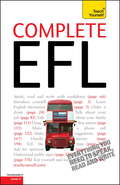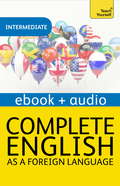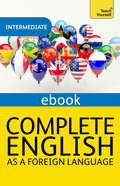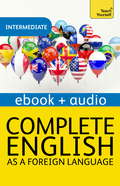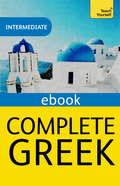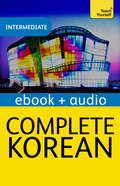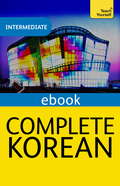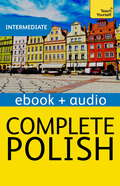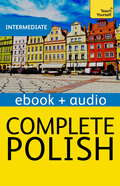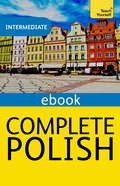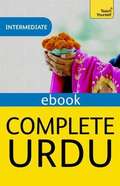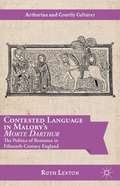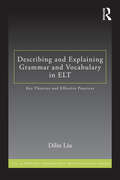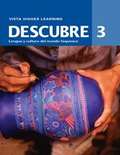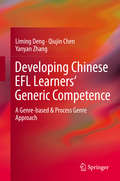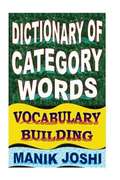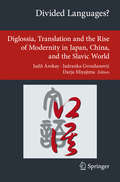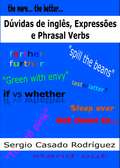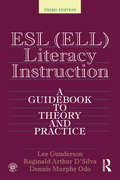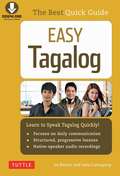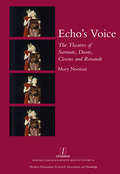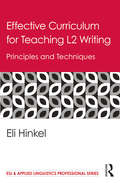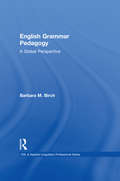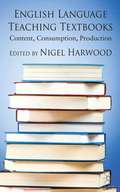- Table View
- List View
Complete English as a Foreign Language Beginner to Intermediate Course
by Sandra StevensAre you looking for a complete course in English as a foreign language which takes you effortlessly from beginner to confident speaker? Whether you are starting from scratch, or are just out of practice, Complete English as a Foreign Language will guarantee success!Now fully updated to make your language learning experience fun and interactive. You can still rely on the benefits of a top language teacher and our years of teaching experience, but now with added learning features within the course and online. The course is structured in thematic units and the emphasis is placed on communication, so that you effortlessly progress from introducing yourself and dealing with everyday situations, to using the phone and talking about work. By the end of this course, you will be at Level B2 of the Common European Framework for Languages: Can interact with a degree of fluency and spontaneity that makes regular interaction with native speakers quite possible without strain for either party.Learn effortlessly with a new easy-to-read page design and interactive features: NOT GOT MUCH TIME?One, five and ten-minute introductions to key principles to get you started.AUTHOR INSIGHTSLots of instant help with common problems and quick tips for success, based on the author's many years of experience.GRAMMAR TIPSEasy-to-follow building blocks to give you a clear understanding.USEFUL VOCABULARYEasy to find and learn, to build a solid foundation for speaking.DIALOGUESRead and listen to everyday dialogues to help you speak and understand fast.TEST YOURSELFTests in the book and online to keep track of your progress.EXTEND YOUR KNOWLEDGEExtra online articles at: www.teachyourself.com to give you a richer understanding of the culture of English speakers.TRY THISInnovative exercises illustrate what you've learnt and how to use it.The course is also available as a book (9781444105926), as a pack comprising the book and double CD (9781444102376) and as a double CD (9781444105483).
Complete English as a Foreign Language Beginner to Intermediate Course: Enhanced Edition
by Sandra StevensComplete English as a Foreign Language is a comprehensive ebook + audio language course that takes you from beginner to intermediate level.The new edition of this successful course has been fully revised and is packed with new learning features to give you the language, practice and skills to communicate with confidence.-Maps from A1 to B1 of the Common European Framework of Reference (CEFR) for languages-Teaches British English with American equivalents-Authentic listening activities - everyday conversations give you a flavour of real British and American English voices-10 learning units plus grammar reference and A-Z word glossary-Discovery Method - figure out rules and patterns to make the language stick-Teaches the key skills - reading, writing, listening and speaking-Learn to learn - tips and skills on how to be a better language learner-Culture notes - learn about the people and places of the English-speaking world-Outcomes-based learning - focus your studies with clear aims-Test Yourself - see and track your own progressComing soon: get our companion app. English course: Teach Yourself is full of fun, interactive activities to support your learning with this course. Apple and Android versions available.Rely on Teach Yourself, trusted by language learners for over 75 years.
Complete English as a Foreign Language Revised: Teach Yourself
by Sandra StevensComplete English as a Foreign Language is a comprehensive ebook language course that takes you from beginner to intermediate level. This ebook is for use with the accompanying audio CDs containing two hours of audio (ISBN 9781473601604). This ebook contains only text and not the audio content. The new edition of this successful course has been fully revised and is packed with new learning features to give you the language, practice and skills to communicate with confidence. -Maps from A1 to B1 of the Common European Framework of Reference (CEFR) for languages -Teaches British English with American English alternatives -10 learning units plus grammar reference and A-Z word glossary -Discovery Method - figure out rules and patterns to make the language stick -Teaches the key skills - reading, writing, listening and speaking -Learn to learn - tips and skills on how to be a better language learner -Culture notes - learn about the people and places of the English-speaking world -Outcomes-based learning - focus your studies with clear aims -Test Yourself - see and track your own progress Coming soon: get our companion app. English course: Teach Yourself is full of fun, interactive activities to support your learning with this course. Apple and Android versions available. Rely on Teach Yourself, trusted by language learners for over 75 years.
Complete English as a Foreign Language Revised: Teach Yourself Ebook
by Sandra StevensComplete English as a Foreign Language is a comprehensive ebook language course that takes you from beginner to intermediate level.This ebook is for use with the accompanying audio CDs containing two hours of audio (ISBN 9781473601604). This ebook contains only text and not the audio content.The new edition of this successful course has been fully revised and is packed with new learning features to give you the language, practice and skills to communicate with confidence. -Maps from A1 to B1 of the Common European Framework of Reference (CEFR) for languages -Teaches British English with American English alternatives-10 learning units plus grammar reference and A-Z word glossary -Discovery Method - figure out rules and patterns to make the language stick -Teaches the key skills - reading, writing, listening and speaking -Learn to learn - tips and skills on how to be a better language learner -Culture notes - learn about the people and places of the English-speaking world -Outcomes-based learning - focus your studies with clear aims -Test Yourself - see and track your own progressComing soon: get our companion app. English course: Teach Yourself is full of fun, interactive activities to support your learning with this course. Apple and Android versions available.Rely on Teach Yourself, trusted by language learners for over 75 years.
Complete English as a Foreign Language: Audio eBook
by Sandra StevensComplete English as a Foreign Language is a comprehensive ebook + audio language course that takes you from beginner to intermediate level. The new edition of this successful course has been fully revised and is packed with new learning features to give you the language, practice and skills to communicate with confidence. -Maps from A1 to B1 of the Common European Framework of Reference (CEFR) for languages -Teaches British English with American equivalents. -Authentic listening activities - everyday conversations give you a flavour of real British and American English voices -10 learning units plus grammar reference and A-Z word glossary -Discovery Method - figure out rules and patterns to make the language stick -Teaches the key skills - reading, writing, listening and speaking -Learn to learn - tips and skills on how to be a better language learner -Culture notes - learn about the people and places of the English-speaking world -Outcomes-based learning - focus your studies with clear aims -Test Yourself - see and track your own progress Rely on Teach Yourself, trusted by language learners for over 75 years.
Complete Greek Beginner to Intermediate Book and Audio Course: EBook: New edition (Teach Yourself Ser.)
by Aristarhos MatsukasComplete Greek is a comprehensive language course that takes you from beginner to intermediate level. Please note that this ebook contains the text only and no audio content. The new edition of this successful course has been fully revised and is packed with new learning features to give you the language, practice and skills to communicate with confidence. -Maps from A1 to B2 of the Common European Framework of Reference (CEFR) for languages -Discovery Method - figure out rules and patterns to make the language stick -Teaches the key skills - reading, writing, listening and speaking -Learn to learn - tips and skills on how to be a better language learner -Culture notes - learn about the people and places of Greece -Outcomes-based learning - focus your studies with clear aims -Authentic listening activities - everyday conversations give you a flavour of real spoken Greek -Test Yourself - see and track your own progress Coming soon: get our companion app. Greek course: Teach Yourself is full of fun, interactive activities to support your learning with this course. Apple and Android versions available. Also available: Get Started in Beginner's Greek (ISBN 9781444101621). Rely on Teach Yourself, trusted by language learners for over 75 years.
Complete Korean Beginner to Intermediate Course: Enhanced Edition
by Jaehoon Yeon Mark VincentComplete Korean is a comprehensive language course that takes you from beginner to intermediate level. The new edition of this successful course has been fully revised and is packed with new learning features to give you the language, practice and skills to communicate with confidence. -Maps from A1 to B2 of the Common European Framework of Reference (CEFR) for languages -384-page book contains 14 learning units plus grammar index and word glossary -Korean script (Hangul) used throughout - for real language immersion -Discovery Method - figure out rules and patterns to make the language stick -Teaches the key skills - reading, writing, listening and speaking -Learn to learn - tips and skills on how to be a better language learner -Culture notes - learn about the people and places of Korea -Outcomes-based learning - focus your studies with clear aims -Authentic listening activities - everyday conversations give you a flavour of real spoken Korean -Test Yourself - see and track your own progress Coming soon: get our companion app. Korean course: Teach Yourself is full of fun, interactive activities to support your learning with this course. Apple and Android versions available. Also available: Get Started in Korean (ISBN 9781444175042). Rely on Teach Yourself, trusted by language learners for over 75 years.This ebook is compatible with Kindle Paperwhite, Kindle Fire and Kindle Fire HD. Unfortunately Kindle DX and ADE do not support this ebook.
Complete Korean Beginner to Intermediate Course: eBook: New edition
by Jaehoon Yeon Mark VincentComplete Korean is a comprehensive ebook language course that takes you from beginner to intermediate level. Please note that this ebook contains the text only and no audio content.The new edition of this successful course has been fully revised and is packed with new learning features to give you the language, practice and skills to communicate with confidence. -Maps from A1 to B2 of the Common European Framework of Reference (CEFR) for languages-Korean script (Hangul) used throughout - for real language immersion -Discovery Method - figure out rules and patterns to make the language stick -Teaches the key skills - reading, writing, listening and speaking -Learn to learn - tips and skills on how to be a better language learner -Culture notes - learn about the people and places of Korea -Outcomes-based learning - focus your studies with clear aims-Test Yourself - see and track your own progress Coming soon: get our companion app. Korean course: Teach Yourself is full of fun, interactive activities to support your learning with this course. Apple and Android versions available. Also available: Get Started in Korean (ISBN 9781444175042). Rely on Teach Yourself, trusted by language learners for over 75 years.This ebook is compatible with iPad, Kindle Paperwhite, Kindle Fire and Kindle Fire HD.
Complete Polish Beginner to Intermediate Course: Enhanced Edition
by Joanna Mickalak-Gray Nigel Gotteri Joanna Michalak-GrayComplete Polish is a comprehensive language course that takes you from beginner to intermediate level.The new edition of this successful course has been fully revised and is packed with new learning features to give you the language, practice and skills to communicate with confidence.-Maps from A1 to B2 of the Common European Framework of Reference (CEFR) for languages-20 learning units plus grammar appendix and word glossary-Discovery Method - figure out rules and patterns to make the language stick-Teaches the key skills - reading, writing, listening and speaking-Learn to learn - tips and skills on how to be a better language learner-Culture notes - learn about the people and places of Poland-Outcomes-based learning - focus your studies with clear aims-Authentic listening activities - everyday conversations give you a flavour of real spoken Polish-Test Yourself - see and track your own progressComing soon: get our companion app. Polish course: Teach Yourself is full of fun, interactive activities to support your learning with this course. Apple and Android versions available.Rely on Teach Yourself, trusted by language learners for over 75 years.
Complete Polish Beginner to Intermediate Course: Enhanced Edition
by Joanna Mickalak-Gray Nigel Gotteri Joanna Michalak-GrayComplete Polish is a comprehensive language course that takes you from beginner to intermediate level. The new edition of this successful course has been fully revised and is packed with new learning features to give you the language, practice and skills to communicate with confidence. -Maps from A1 to B2 of the Common European Framework of Reference (CEFR) for languages -20 learning units plus grammar appendix and word glossary -Discovery Method - figure out rules and patterns to make the language stick -Teaches the key skills - reading, writing, listening and speaking -Learn to learn - tips and skills on how to be a better language learner -Culture notes - learn about the people and places of Poland -Outcomes-based learning - focus your studies with clear aims -Authentic listening activities - everyday conversations give you a flavour of real spoken Polish -Test Yourself - see and track your own progress Coming soon: get our companion app. Polish course: Teach Yourself is full of fun, interactive activities to support your learning with this course. Apple and Android versions available. Rely on Teach Yourself, trusted by language learners for over 70 years.
Complete Polish Beginner to Intermediate Course: Learn to read, write, speak and understand a new language with Teach Yourself
by Joanna Mickalak-Gray Nigel Gotteri Joanna Michalak-GrayComplete Polish is a comprehensive book and audio language course that takes you from beginner to intermediate level.The new edition of this successful course has been fully revised and is packed with new learning features to give you the language, practice and skills to communicate with confidence.-Maps from A1 to B2 of the Common European Framework of Reference (CEFR) for languages-20 learning units plus grammar appendix and word glossary-Discovery Method - figure out rules and patterns to make the language stick-Teaches the key skills - reading, writing, listening and speaking-Learn to learn - tips and skills on how to be a better language learner-Culture notes - learn about the people and places of Poland-Outcomes-based learning - focus your studies with clear aims-Authentic listening activities - everyday conversations give you a flavour of real spoken Polish (for use with CD, bought separately)-Test Yourself - see and track your own progressIn this pack you'll get a 320-page book.Also available: Get Started in Beginner's Polish (ISBN 9781444174830).Rely on Teach Yourself, trusted by language learners for over 75 years.
Complete Urdu (Learn Urdu with Teach Yourself)
by David Matthews Mohamed Kasim DalviComplete Urdu is a comprehensivelanguage course that takes you from beginner to intermediate level. The new edition of this successful course has been fully revised and is packed with new learning features to give you the language, practice and skills to communicate with confidence. -Maps from A1 to B2 of the Common European Framework of Reference (CEFR) for languages -17 learning units plus reading and writing section and word glossaries -Discovery Method - figure out rules and patterns to make the language stick -Teaches the key skills - reading, writing, listening and speaking -Learn to learn - tips and skills on how to be a better language learner -Culture notes - learn about the people and places of Pakistan and the Urdu-speaking regions of India -Outcomes-based learning - focus your studies with clear aims -Authentic listening activities - everyday conversations give you a flavour of real spoken Urdu -Test Yourself - see and track your own progress Coming soon: get our companion app. Urdu course: Teach Yourself is full of fun, interactive activities to support your learning with this course. Apple and Android versions available. Rely on Teach Yourself, trusted by language learners for over 75 years.
Contested Language In Malory’s Morte Darthur
by Ruth LextonMalory's Morte Darthur, which transformed the sprawling thirteenth-century French Vulgate Cycle romances for fifteenth-century English readers, is often seen as the culmination of the medieval Arthurian tradition and a consolidation of Arthur's reputation as a perfect chivalric ruler. Examining Malory's political language, this study challenges the accepted view of Arthur's kingship and the role of the Round Table fellowship. Considering a range of historical and political sources, Ruth Lexton suggests that Malory used a specific lexicon to engage with contemporary problems of kingship and demonstrates that the Morte interrogates the collapse of the English monarchy during the Wars of the Roses. .
Describing and Explaining Grammar and Vocabulary in ELT: Key Theories and Effective Practices (ESL & Applied Linguistics Professional Series)
by Dilin LiuLanguage description plays an important role in language learning/teaching because it often determines what specific language forms, features, and usages are taught and how. A good understanding of language description is vital for language teachers and material writers and should constitute an important part of their knowledge. This book provides a balanced treatment of both theory and practice. It focuses on some of the most important and challenging grammar and vocabulary usage questions. Using these questions as examples, it shows how theory can inform practice and how grammar and vocabulary description and explanation can be made more effective and engaging. Part I describes and evaluates the key linguistic theories on language description and teaching. Part II discusses and gives specific examples of how challenging grammar and vocabulary issues can be more effectively described and explained; each chapter focuses on one or more specific grammar and vocabulary. An annotated list of useful free online resources (online corpora and websites) for grammar and vocabulary learning and teaching, and a glossary provide helpful information.
Developing Chinese EFL Learners' Generic Competence
by Liming Deng Qiujin Chen Yanyan ZhangThis work investigates the development of English as a Foreign Language (EFL) learners' generic competence in reading, writing and translation within the particular Chinese classroom context. It provides a new perspective for the current teaching and research in reading, writing, translation within the EFL contexts and offers an insightful framework for pedagogical applications in language learning and teaching. Its findings will be extremely valuable not only in local situations, but also more generally in a wider regional and global context as well. The book employs a series of research tools, including pre-research and post-research questionnaires, pre-test and post-test of reading/writing/translation, multi-faceted writing portfolios (including reflection reports), textual analysis and in-depth interviews. It involves 209 participants from a primary university in Wuhan, among whom 171 are undergraduates and 38 are postgraduates. And it draws on the analysis of such varied multi-sourced data both qualitatively and quantitatively. Genre-based teaching is playing a critical role in initiating EFL learners into the discourse community of the target language. Developing EFL learners' generic competence is viewed as the ultimate goal in the process of teaching and learning. This monograph effectively demonstrates that like genre-based English for Specific Purposes (ESP) pedagogies, it is also possible to take advantage of already acquired genre knowledge for use in EFL learning contexts. It offers an impressive view of the direction in which genre-based applications are likely to take in the coming years.
Dictionary of Category Words: Vocabulary Building (English Word Power #12)
by Manik JoshiDictionary of Category Words: Vocabulary Building (English Word Power) (Volume 12) by Manik Joshi.
Divided Languages?
by Judit Árokay Jadranka Gvozdanović Darja MiyajimaThe present volume is a collection of papers presented at the international conference "Linguistic Awareness and Dissolution of Diglossia" held in July 2011 at Heidelberg University. The aim is to reevaluate and compare the processes of dissolution of diglossia in East Asian and in European languages, especially in Japanese, Chinese and in Slavic languages in the framework of the asymmetries in the emergence of modern written languages. Specialists from China, Japan, Great Britain, Germany and the U. S. contributed to the volume by introducing their research focusing on aspects of the dissolution of diglossic situations and the role of translation in the process. The first group of texts focuses on the linguistic concept of diglossia and the different processes of its dissolution, while the second investigates the perception of linguistic varieties in historical and transcultural perspectives. The third and final group analyses the changing cultural role and function of translations and their effect on newly developing literary languages.
Dúvidas de Inglês, Expressões e Phrasal Verbs
by Sergio Casado Rodríguez Beatriz AntunesEste é um livro projetado para estudantes de nível intermediário de inglês que querem completar seu vocabulário com alguns phrasal verbs e expressões idiomáticas e para resolver dúvidas comuns que geralmente aparecem durante o aprendizado.
ESL (ELL) Literacy Instruction: A Guidebook to Theory and Practice
by Lee Gunderson Dennis Murphy Odo Reginald D'SilvaESL (ELL) Literacy Instruction provides both ESL and mainstream teachers with the background and expertise necessary to plan and implement reading programs that match the particular needs and abilities of their students. Comprehensive and research-based, it applies current ESL and reading research and theory to practice. Designed for use by pre-service and in-service teachers at all levels from kindergarten to adult learners, it explains different models of literacy instruction from systematic phonics to whole language instruction and includes specific teaching methods within each model. Multicultural issues are addressed. Instructional matrices that account for the wide variations in ESL (ELL) student backgrounds and abilities form the pedagogical basis of the approach described in the text. The matrices, based on extensive research, involve two easily measured variables that predict what programs and approaches will be comprehensible for learners who vary in age, literacy background, English ability, and program needs. Readers are encouraged to develop their own teaching strategies within their own instructional models.
Easy Tagalog: Learn to Speak Tagalog Quickly
by Joi Barrios Julia CamagongEasy Tagalog brings the Tagalog language and culture of the Philippines alive, giving you all the basics you need to start speaking basic Tagalog immediately. <P><P>The opening chapters introduce the essentials of Tagalog pronunciation and sentence construction, showing you how to build simple Tagalog sentences. Each subsequent chapter gives a short, easy dialogue that's useful in an everyday situation, along with a new set of sentence patterns and a vocabulary list to help you gradually build up your knowledge and repertoire for activities like making new acquaintances, going shopping, and much more. Every chapter contains helpful information on the customs and culture of this warm and friendly island nation, so that you'll soon be able to talk with ease about everything from the weather to your job and home and family. An extensive glossary at the back and a variety of interesting practice activities, with answer keys, help you build your fluency. The audio disc is a great way to learn Tagalog and gives you a solid foundation in correct pronunciation and helps you get a feel for the spoken language. Let Filipino experts Barrios and Camagong teach you how to enjoy this beautiful language.
Echo's Voice: The Theatres of Sarraute, Duras, Cixous and Renaude
by Mary NoonanHelene Cixous (1937-), distinguished not least as a playwright herself, told Le Monde in 1977 that she no longer went to the theatre: it presented women only as reflections of men, used for their visual effect. The theatre she wanted would stress the auditory, giving voice to ways of being that had previously been silenced. She was by no means alone in this. Cixous's plays, along with those of Nathalie Sarraute (1900-99), Marguerite Duras (1914-96), and Noelle Renaude (1949-), among others, have proved potent in drawing participants into a dynamic 'space of the voice'. If, as psychoanalysis suggests, voice represents a transitional condition between body and language, such plays may draw their audiences in to understandings previously never spoken. In this ground-breaking study, Noonan explores the rich possibilities of this new audio-vocal form of theatre, and what it can reveal of the auditory self.
Effective Curriculum for Teaching L2 Writing: Principles and Techniques (ESL & Applied Linguistics Professional Series)
by Eli HinkelEffective Curriculum for Teaching L2 Writing sets out a clear big picture for curricular thinking about L2 writing pedagogy and offers a step-by-step guide to curriculum design with practical examples and illustrations. Its main purpose is to help pre-service and practicing teachers design courses for teaching academic writing and to do this as efficiently and effectively as possible. Bringing together the what and the how-to with research-based principles, what sets this book apart is its overarching focus on language pedagogy and language building. Part 1 examines curricular foundations in general and focuses on what is socially valued in L2 writing and pedagogy at school and at the college and university level. Part 2 is concerned with the nitty-gritty̶—the daily realities of curricular design and classroom instruction. Part 3 takes a close look at the key pedagogical ingredients of teaching academic L2 writing: vocabulary and collocations, grammar for academic writing, and down-to-earth techniques for helping L2 writers to organize discourse and ideas. The Appendix provides an extensive checklist for developing curricula for a course or several courses in language teaching.
English Grammar Pedagogy: A Global Perspective (ESL & Applied Linguistics Professional Series)
by Barbara M. BirchDesigned for ESL and ELT pedagogy courses around the world, this text describes English grammar from a World Englishes perspective. It is distinguished by its focus on the social setting for English as a global language, the latest thinking about grammatical theory, and new theories of how first and second languages are learned and taught. The fundamental premise is that teaching and learning grammar cannot be isolated from the local, regional, and global sociocultural contexts in which the teaching and learning take place. Part I presents different attitudes toward English as a global language and some challenges that learners of English share no matter where they are in the world. Part II is about the features of English that educated speakers consider the most likely and probable in Academic English. Part III describes the flexible and fluid features of English that might be susceptible to change or modification over time. Each chapter includes engaging Study, Discussion, and Essay Questions and Activities.
English Language Teaching Textbooks
by Nigel HarwoodEnglish language teaching textbooks (or coursebooks) play a central role in the life of a classroom. This edited volume contains research-informed chapters focusing on: analysis of textbook content; how textbooks are used in the classroom; and textbook writers' accounts of the materials writing, design, and publishing process.
